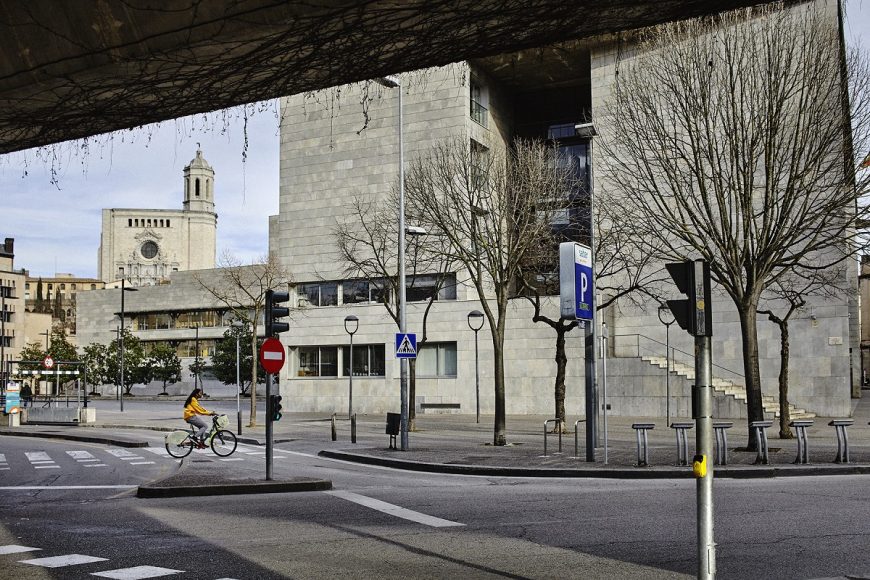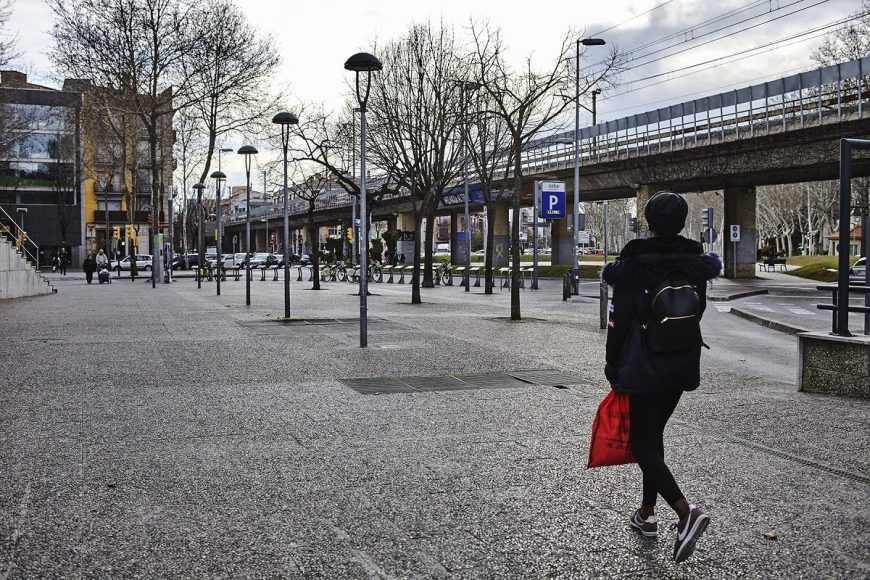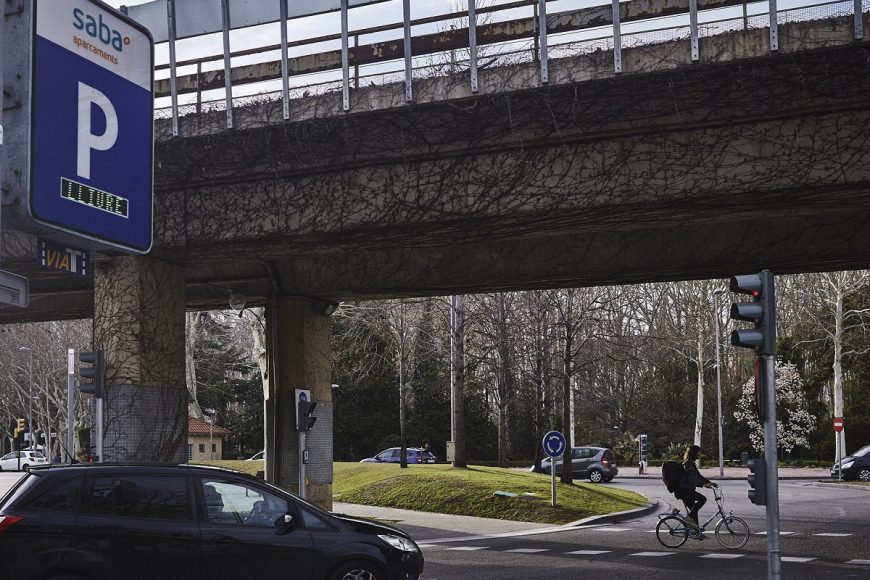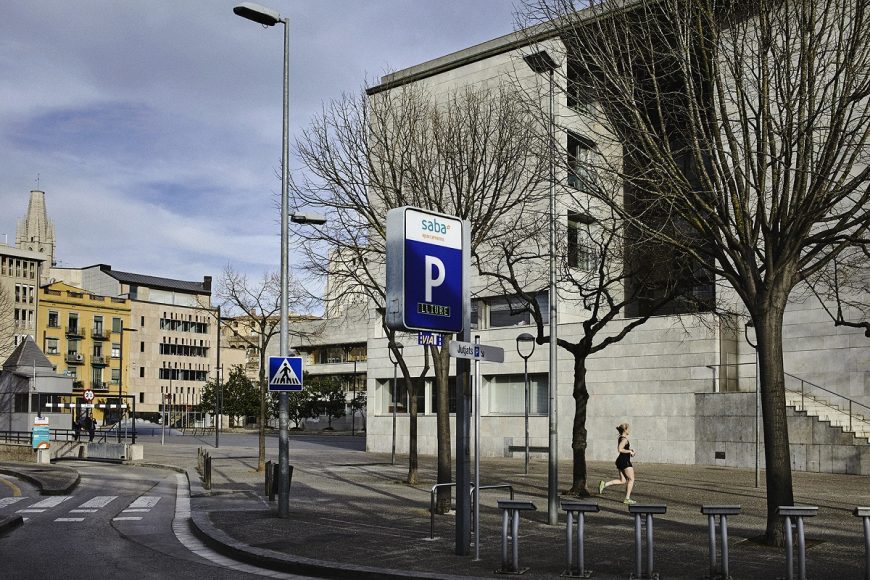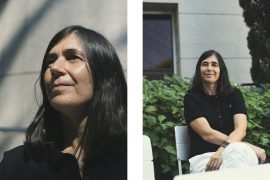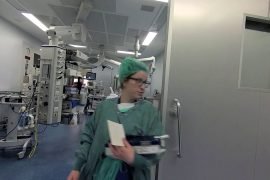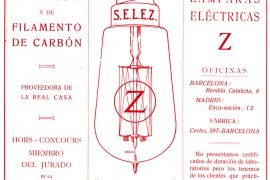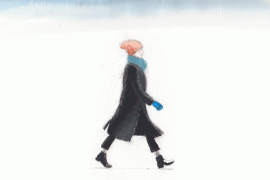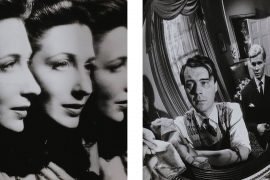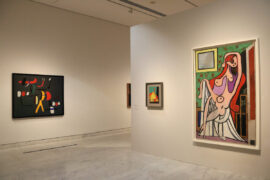[dropcap letter=”I”]
t’s funny that a historian lends his name to a square that apparently has no history whatsoever. A bit of time walking around and keeping your ears peeled in Plaça Jaume Vicens Vives in Girona yields up a bunch of conversations and facets that were hidden at first. The square is located behind the courts of Girona, near the Parc de la Devesa, whose plane trees, stripped by the winter, made a soft blur on the horizon. Attached to the square is Carrer de Berenguer i Carnicer (named after a man of the Church from the 18th century) and a car park with a prominent entrance, a structure crowned by a pyramidal shape reminiscent of vintage newsstands, that vintage which no one knows whether it ever existed but everyone identifies as vintage. In a drizzle, the structure at the entrance to the car park becomes a shelter for passionate citizens and quick conversations:-
– Are you walking?
– Yes, but don’t worry – tentative, almost imperceptible hesitation.
– Come on, I’ll take you. It’ll just be a minute – she says, with more determination.
Or perhaps a lady complaining about the wastefulness on the credit card of someone who clearly doesn’t split hairs. Or a young man’s long telephone conversation on a thyroid problem; the fellow seems to have been waiting for some time and is taking advantage of it to while away the seconds with a conversation that could well be about the sex of angels and would end up serving the same purpose.
Looking towards the Onyar River – which is running quite full – is the archetypal silhouette of Girona, with the colourful houses, the cathedral and the church. Just a stone’s throw away, at the way out from the square is the independent theatre La Planeta, which leads to Carrer Jeroni Real de Fontclara, named after a 17th-century chronicler. What landscape must the chronicler have seen if he ever had time to stop in this square? In his day was it a nerve centre or an unknown periphery?
The square behind the courts offers the peace and quiet that cannot be found on the main façade, where the entire urban web is electric. The poster glued to one of those circular points covered with announcements advertises a performance by La Niña Bonita La Húngara in La Mirona club accompanied by a guest artist: Laury, la Hungarilla. The logical mechanism of things provides an almost balm-like security. La Húngara and La Hungarilla. Okay, let’s keep going. We move towards the centre of the square, paved with dark slabs, where there is a sculpture which aims to represent the solar system and its planets. In the same vein, just by the courthouse – a grey, L-shaped mass – is a row of eleven magnolias. In view of details like this one, one grasps at a remote idea of universal harmony, and the tourist signs lead me in the direction of the “Jewish quarter, museums and the cathedral”. That places me at a corner of the square, a new perspective. Looking towards the Onyar River – which is running quite full – is the archetypal silhouette of Girona, with the colourful houses, the cathedral and the church. Just a stone’s throw away, at the way out from the square is the independent theatre La Planeta, which leads to Carrer Jeroni Real de Fontclara, named after a 17th-century chronicler. What landscape must the chronicler have seen if he ever had time to stop in this square? In his day was it a nerve centre or an unknown periphery?
The square insists on offering facets and more facets of life just when it seemed like another grey, square-shaped square with its Barristers’ Association as the colophon of a rational logic which the space seems to flaunt
From this corner, here and now, an ancient building remains standing, whose days seem to be numbered (the others are new or tastefully remodelled). On its façade are peeling letters commemorating a whiff of what it used to be: “We are moving. C/ Santa Eugènia, 108”. They apparently moved a while ago. Here, just about to enter the courthouse car park, two vehicles from “Undertakers, Judicial Transport” are waiting to make a kind of transfer. Once the operation of gulping before this exotic view has passed, a question inevitably remains: who are these vans transporting, and what is their backstory?
The square insists on offering facets and more facets of life just when it seemed like another grey, square-shaped square with its Barristers’ Association as the colophon of a rational logic which the space seems to flaunt. But we never see the content, the exact weight, of the scales of justice, which we assume now to be balanced and heavy. Likewise, urban landscapes also conceal fathomless surprises which are not discovered either the first or even the second time around. The laughing mask on the façade of La Planeta theatre is a reminder for the unwitting person who might think that they know it all, like the tourist who rapidly vaults from one museum gallery to another, exclaiming, “There’s nothing to see here”. I ask a friend, a professional Girona denizen, what this square might tell me, what there used to be here (in that indeterminate “before”, which begins and ends I know not when, which superimposes new facets and calluses onto the landscape we’re seeing). I ask her without much hope of an answer, expecting that she’ll wonder about my excessive interest in a square that would not go down in history. But her answer is on par with my blasé scepticism:
– Well, there used to be (there is) the first floor where I lived. And across from that is the slaughterhouse. I remember watching lorries leave with huge chunks of meat cleaved top to bottom. La Planeta used to be a Sarfa bus station.
My eyes widen as she continues her detailed story:
– The fire station used to be where the entrance to the courthouse is. Behind it, in what is now the square – right where the planets in the solar system are – was the slaughterhouse. And across from the cinema – that is, across from what is now the Albèniz Centre cinemas, where one wing of the courthouse is – there was a central dairy. I used to go there to buy a bag of milk for five pesetas. It made a stench that I can still smell.

